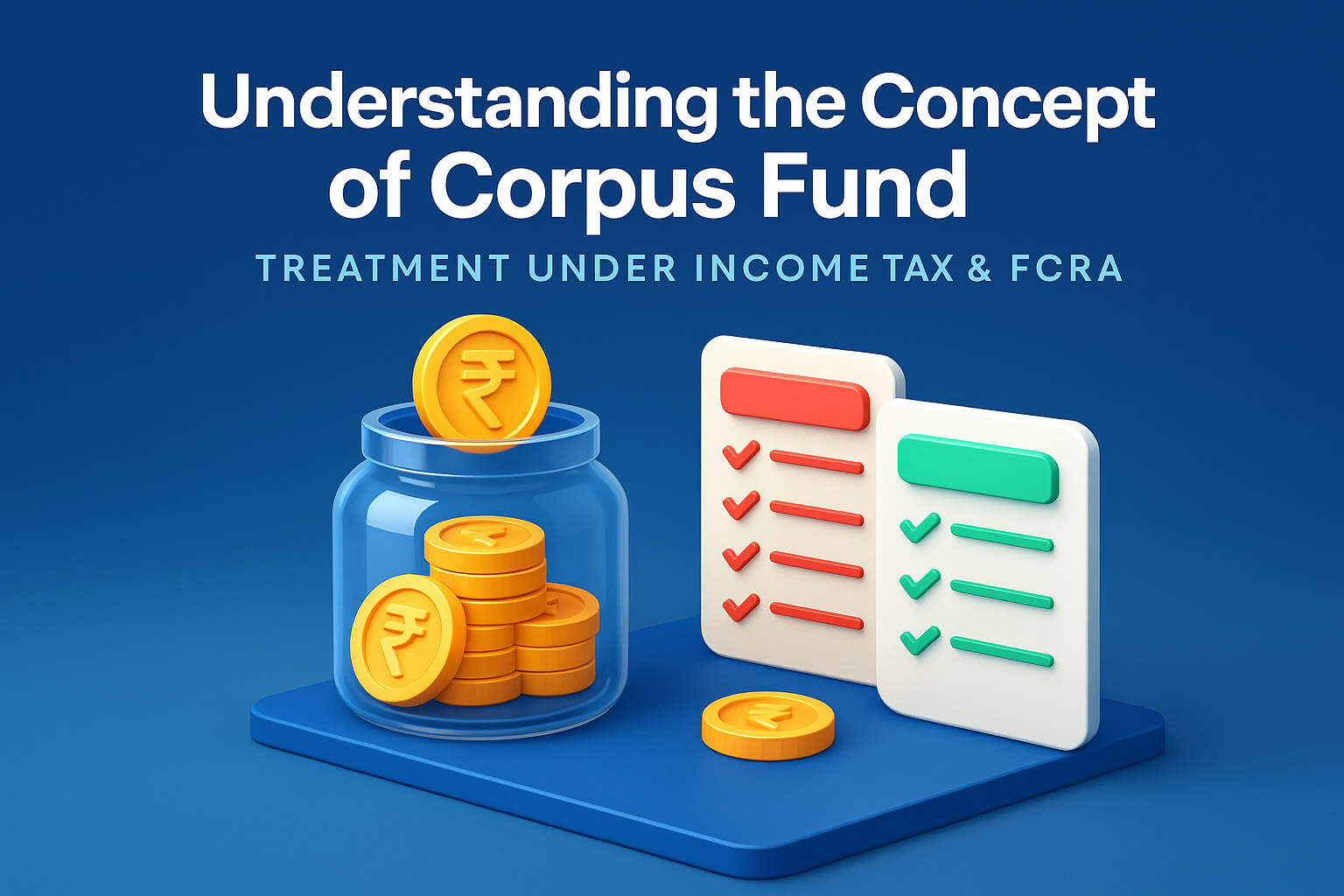
Understanding the Concept of Corpus Fund
– Treatment Under Income Tax & FCRA
Introduction
Corpus funds are a cornerstone of financial sustainability for NGOs, representing donations designated for long-term preservation to ensure organizational stability. Their treatment under the Income Tax Act, 1961, and the Foreign Contribution (Regulation) Act, 2010, is critical for compliance, tax benefits, and effective financial management. This section provides a comprehensive analysis of the definition, legal treatment, management practices, and challenges associated with corpus funds, equipping NGOs with the knowledge to leverage these resources responsibly.
Definition of Corpus Fund
A corpus fund is a reserve of donations specifically directed by donors to remain intact as capital, with only the income generated (e.g., interest, dividends) used for charitable purposes. Unlike general donations, corpus funds are not expended directly but serve as a financial backbone for long-term sustainability, funding recurring programs or capital projects.
Example: “Care India Trust,” an NGO focused on healthcare, receives a 50 lakh donation from a corporate donor with explicit instructions to maintain it as a corpus fund. The trust invests the amount in fixed deposits, using the annual interest of 3.5 lakhs to fund medical camps.
Treatment Under Income Tax Act
The Income Tax Act, 1961, provides specific provisions for the tax treatment of corpus funds:
- The donor’s intent to create a corpus must be documented in writing, such as through a donation agreement or letter.
- The principal amount must be preserved and not used for revenue expenditure.
- The income generated must be applied to charitable purposes, as per Section 2(15).
Example: “Care India Trust” receives a 20 lakh corpus donation, documented in a donor letter, and invests it in a government bond yielding 7.
Treatment Under FCRA
The FCRA, 2010, governs foreign contributions received by NGOs, including those designated as corpus funds:
Example: “Care India Trust” receives a 10 lakh foreign corpus donation from a US-based foundation, deposits it in an SBI FCRA account, and invests it in a fixed deposit. It reports the 70,000 annual interest usage for medical equipment in Form FC-4 for FY 2024-25, ensuring compliance.
Management Practices for Corpus Funds
To ensure compliance and transparency, NGOs must adopt robust management practices:
Transparency: Disclose corpus fund details in annual reports and financial statements, enhancing donor trust.
Pros and Cons
Pros:
- Provides long-term financial stability, ensuring sustained funding for programs.
- Tax exemptions under Section 11(1)(d) reduce financial liability.
- Enhances donor confidence by demonstrating commitment to sustainability.
- Supports large-scale or capital projects, such as building schools or hospitals.
Cons:
- Strict compliance requirements, including donor documentation and investment restrictions, add complexity
- Limited immediate access to funds, as the principal cannot be used for operations.
- FCRA reporting and banking requirements increase administrative costs.
- Risk of penalties for non-compliance or misuse, requiring robust governance.
Reforms and Solutions
Recent Updates (2025)
As of June 8, 2025, the Finance Act, 2021, introduced provisions to prevent misuse of corpus funds, requiring clear documentation of donor intent and stricter verification during tax assessments. The FCRA Amendment, 2020, continues to require foreign corpus funds to be held in SBI accounts, with increased scrutiny in MHA audits. No specific amendments to corpus fund rules have been announced in 2025, but the CBDT’s focus on digital transparency underscores the need for accurate reporting.
Table 3: Corpus Fund Treatment: Income Tax vs. FCRA
| Aspect | Income Tax | FCRA |
| Taxation | Exempt under Section 11(1)(d) if preserved | Not taxed, but strict utilization rules apply |
| Account Requirement | Separate accounting recommended | Mandatory SBI FCRA account |
| Investment | Approved securities under Section 11(5) | Fixed deposits, no speculative investments |
| Reporting | Disclosed in ITR-7 | Reported in Form FC-4 |
Conclusion
Corpus funds are essential for NGOs’ long-term sustainability, offering tax exemptions and a stable financial base. However, their management requires careful compliance with Income Tax and FCRA regulations, including clear documentation, approved investments, and regular reporting. By adopting robust governance practices and advocating for simplified regulations, NGOs can maximize the benefits of this funding model while minimizing risks.
Non-Profit Structures in India: Section 8 Companies, Trusts, Societies, and AOP/BOIs In India,...
Electoral Trusts and Electoral Bonds: An In-Depth Overview 1. Introduction Political funding...
Difference Between Voluntary Contributions, Corpus Donations, and Anonymous Donations I...
A Comprehensive Guide to Social Audit in India In the modern era, citizens have become ...
Impact of Mandatory Aadhaar Linking for NGO Trustees – Legal Validity & Privacy Concer...
Difference Between Trust, Society, and Section 8 Company Selecting the right NGO structure (Trus...
Latest Rules for Renewal of 12AB & 80G Registrations Under current tax law, registe...
Corpus Donations: Legal Definition & Practical Use What is a Corpus Donation? A c...
Understanding Societies in India: Formation, Governance, and Legal Framework Introduc...
What is Form 10BB and How to File It – Audit Report for Charitable Institutions ...